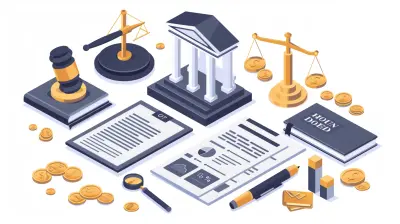Understanding Interest Rate Risk in Your Investment Portfolio
20 September 2025
Let’s be real—investing can feel like navigating a jungle blindfolded. One minute you're watching your stocks soar, the next, you hear the dreaded term: interest rate hikes. If you’ve ever wondered why changing interest rates seem to shake up your investment returns, you’re not alone.
Welcome to the world of interest rate risk—a sneaky little gremlin that hides in your portfolio and messes with your carefully laid financial plans. But fear not! By the end of this article, you’ll understand what interest rate risk is, how it affects your investments, and—most importantly—how to protect yourself from it.

What Exactly Is Interest Rate Risk?
Let’s start with the basics.Interest rate risk is the risk that changes in interest rates will negatively impact the value of your investments. It most often rears its ugly head in the world of bonds, but it can also shake up stocks and even real estate.
Here’s a super simple analogy: Imagine you bought a vintage record player for $100. You love it. It plays your vinyl collection like a dream. Now imagine a newer model comes out that’s cheaper, plays music from Bluetooth, and makes you coffee (okay, maybe not that last one). Your $100 record player doesn’t seem like such a great deal anymore, right?
That’s how bonds feel when interest rates rise. Investors no longer want your old bond because new ones are offering better returns. So the value of your bond drops—ouch.

Why Should You Care?
Whether you're a newbie investor or a retirement-ready pro, interest rate risk affects everyone.- Are you holding bonds for safety? They could lose value.
- Relying on dividends from stocks? Those might dip.
- Thinking about getting into real estate? Rates can play tricks there too.
So yeah, interest rates matter—a lot.

The Dance Between Interest Rates and Bonds
Let’s get into the nitty-gritty of how this risk plays out. Bonds are like little loans you give to the government or a company. In return, they promise to pay you interest (called a coupon) and return the money when the bond matures.Now here’s the key: Bond prices and interest rates have an inverse relationship. When one goes up, the other goes down. Think of it like a financial seesaw.
Example Time!
Say you buy a 10-year bond that pays 3% interest. Pretty sweet, right?Now, six months later, interest rates jump to 4%. Suddenly, new bonds pay more! So if you want to sell your 3% bond, you’ll have to offer a discount to entice buyers. No one wants an old, low-interest bond when they can get a better deal elsewhere.
That price drop? Bingo—interest rate risk in action.

Duration: The Secret Weapon (or Weak Spot)
Ever hear the term duration thrown around in investing circles and just nod politely? You're not alone.Duration measures a bond’s sensitivity to interest rate changes. Think of it as the bond’s drama level. The higher the duration, the more dramatic the bond is when interest rates change.
Here’s how it works:
- Short-duration bonds = Less risky when rates rise
- Long-duration bonds = More sensitive and more volatile
If you’re the type who wants to sleep well at night, shorter-duration bonds might be your BFF.
How Interest Rate Risk Impacts Other Assets
Okay, bonds steal the spotlight in this convo, but they’re not the only ones feeling the pressure.1. Stocks and Interest Rates: A Complicated Relationship
When rates go up, borrowing becomes more expensive. Companies might slow down investments. Consumers might spend less. All of this can put a damper on business profits—leading to (you guessed it) lower stock prices.Now, not all stocks react the same. Growth stocks (like tech companies) are usually more sensitive to rising rates than value stocks (like your reliable utility companies).
2. Real Estate: Feeling the Squeeze too
Higher interest rates = higher mortgage rates = fewer buyers. That can lead to lower property values over time. So if you have real estate in your portfolio, rising rates can definitely leave a mark.
Strategies to Manage Interest Rate Risk Like a Pro
Now let’s flip the script. What can you actually do about all this?1. Diversify Like You Mean It
The golden rule: don’t put all your eggs in one basket. Mixing bonds with different maturities (short-term, mid-term, long-term), tossing in stocks, and maybe even a bit of real estate or commodities can help you cushion any shocks.Think of your portfolio like a buffet—variety is delicious and smart.
2. Ladder Your Bonds
This is a fancy term for a simple idea. You buy bonds that mature at different intervals (say, 1-year, 3-year, 5-year). That way, as older bonds mature, you can reinvest in new ones at higher rates. It’s like upgrading parts of your car instead of buying a whole new one every time.3. Keep an Eye on the Fed
No need to stalk Jerome Powell, but staying informed about Federal Reserve policies can help you anticipate interest rate movements. When the Fed talks, markets listen, and you should too.4. Invest in Floating Rate Funds
Unlike traditional bonds, floating rate bonds adjust their interest payments based on market rates. So when interest rates go up, so does your return. Not a bad deal!5. Consider Bond Funds Carefully
Bond mutual funds and ETFs are convenient, but they don’t have maturity dates like individual bonds. That means you can’t just wait out rate hikes. Be cautious with long-duration bond funds if rising interest rates are on the horizon.Adjusting Your Portfolio for Different Life Stages
Here’s the thing: interest rate risk doesn’t affect everyone the same way. Where you are in your financial journey matters.Young Investors (20s–30s)
You’ve got time on your side. You can handle more volatility, and bonds probably aren’t a huge part of your portfolio yet. Focus more on growth, but keep interest rate risk in mind as you begin diversifying.Mid-Life Savers (40s–50s)
Alright, now you're building serious wealth. Bonds might start playing a bigger role. This is the time to really think about duration and maybe start easing into laddering strategies.Retirees (60s+)
Safety and income are key. You're likely more exposed to interest rate risk through bonds and fixed-income funds. Stick to shorter durations and consider diversifying with dividend-paying stocks or annuities.
Emotional Investing: Don’t Let Rate Hikes Rattle You
Let's be honest—market news can rattle the best of us. Seeing headlines like “Interest Rates Surge” can lead to knee-jerk decisions.But here’s your gentle reminder: emotions are a terrible financial advisor.
Instead of panicking, reassess your portfolio. Does it still align with your goals and time horizon? If yes, breathe easy. If not, make small adjustments—no need for a full-blown overhaul.
Quick Recap: Your Interest Rate Risk Toolkit
Feeling overwhelmed? Don't worry—here’s a bite-sized checklist to keep you grounded:✔️ Understand how your bonds react to rate changes
✔️ Diversify across assets and durations
✔️ Consider bond ladders or floating-rate options
✔️ Tune in (lightly) to Federal Reserve moves
✔️ Align your portfolio with your life stage
✔️ Don’t invest with your emotions
Final Thoughts: Turn the Risk Into a Strategy
It's easy to see interest rate risk as something scary and unpredictable. But here's a little secret—every risk is an opportunity in disguise.By staying informed and making smart, intentional choices, you can actually use interest rate changes to your advantage. Think of it less like a storm and more like the wind in your financial sails. With the right adjustments, you’ll be steering your ship straight toward your long-term goals.
Investing is a marathon, not a sprint. And just like the weather, rates will go up, and then they’ll go down. The key is to be ready, not reactive.
So go ahead—check your portfolio, make those tweaks, and keep moving forward. You've totally got this.
all images in this post were generated using AI tools
Category:
Interest Rates ImpactAuthor:

Yasmin McGee
Discussion
rate this article
1 comments
Rook Richardson
Great article! Interest rate risk can feel daunting, but understanding it is key to making informed investment choices. Thanks for breaking it down in such a relatable way—super helpful for all investors!
October 8, 2025 at 4:55 AM

Yasmin McGee
Thank you for your kind words! I'm glad you found the article helpful in demystifying interest rate risk. Happy investing!


